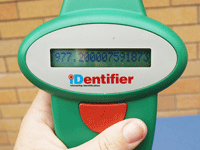Microchips for pets – why should you consider one of these? They cost money, you need to make a trip to the vet and your poor pet will have a piece of foreign material injected into them! In this article we take a look at how important microchips can be.
What is a microchip?
Microchips for pets can be implanted under the skin of many animals including cats, dogs, horses, birds, and tortoises. They are inert devices about the size of a large grain of rice. Each chip is coded with a unique number which can be read by a hand held scanner. The chip number is logged on a database and corresponds with details of the animal’s owner given at the time the microchip was placed.

Microchips are about the size of a large grain of rice and are implanted under your pet’s skin using a special device
If a lost animal is found, local authorities, rescue centres and veterinary surgeries can scan them. The microchip details are checked against a database and the animal is identified. The database operator then gives out the details of the owner of that animal so that they may be contacted, and reunited with their pet.
Why microchip pets?

Many rescue centres now microchip pets before they’re homed. Some of the animals that end up in shelters will have owners frantically trying to trace them. When you think how simple the microchip for pets system is, it’s a shame that not every pet is microchipped!
Imagine losing your dog or cat; you have a much greater chance of a happy outcome when your pet has a microchip.
By law, dogs have to wear an identifying tag including their owner’s contact details. However it’s possible for collars or tags to come off when a dog is lost. Similarly, cats are quite good at losing collars, and they have an added problem that they can suffer injuries from their collars.

When a microchipped pet is scanned with a handheld scanner, the microchip number is shown on the screen
With a microchip for pets placed between a cat or dog’s shoulder blades just under the skin, you have a permanent, inexpensive way to identify them. The tissue in that area fuses around the chip holding it in place. Very occasionally chips migrate, bit they usually remain where they were first placed.
They’re simple to implant, it takes seconds and no sedation is required. At routine vet visits, ask your vet to check that the chip is still in place for your peace of mind.
Is it a legal requirement for a dog to be microchipped?
On 6 February 2013 the government announced it will be introducing legislation to make microchipping of all dogs compulsory in England from 6 April 2016. From this date, owners will need to have their dog microchipped and registered on one of the authorised commercial databases available. The details of any new owner must be added before they sell or give the dog away and they must keep their contact details up to date on the microchip databases. If a dog is not chipped by this date, that owner will be given a short period to comply with this law, otherwise they’ll be fined. The Welsh Government has also announced that microchipping will be compulsory for all dogs in Wales by 1st March 2015.
Are there any other advantages to microchips for pets apart from reuniting lost pets with owners?

Imagine losing your dog or cat; you have a much greater chance of a happy outcome when you microchip your pet.
There are many advantages to microchips for pets. For animals that now travel abroad, microchips for pets are an essential requirement for completion of their passport, and the chip number will be checked several times during travel.
Sadly, theft of beloved pets does happen. Whilst having them microchipped might not stop a theft, there are many cases where microchips for pets have led to owners being reunited with a stolen pet.
If an animal is injured and taken to a vet and a microchip is found, the vet can quickly contact the animal’s owner to ensure that a much loved pet gets the best treatment straight away.
Cats can even have cat flaps programmed just for their microchip to keep the neighbourhood cats out, whilst allowing them to reliably come and go as they please!
So, in conclusion, microchips for pets have major benefits for animals and owners. It’s inexpensive and simple to have one placed. Once your details are logged, should your pet go missing, you have the realistic expectation that they’ll be found and you’ll get the call to go and collect them… all thanks to your pet’s chip!
It’s obviously vital that you make sure your contact details are kept up to date, and if you’re not sure, contact the database operators to check. If you ask any of the centres that place microchips, they’ll be able to give you the necessary contact details.
 The Veterinary Expert| Pet Health
The veterinary expert provides information about important conditions of dogs and cats such as arthrits, hip dysplasia, cruciate disease, diabetes, epilepsy and fits.
The Veterinary Expert| Pet Health
The veterinary expert provides information about important conditions of dogs and cats such as arthrits, hip dysplasia, cruciate disease, diabetes, epilepsy and fits.
 The Veterinary Expert| Pet Health
The veterinary expert provides information about important conditions of dogs and cats such as arthrits, hip dysplasia, cruciate disease, diabetes, epilepsy and fits.
The Veterinary Expert| Pet Health
The veterinary expert provides information about important conditions of dogs and cats such as arthrits, hip dysplasia, cruciate disease, diabetes, epilepsy and fits.